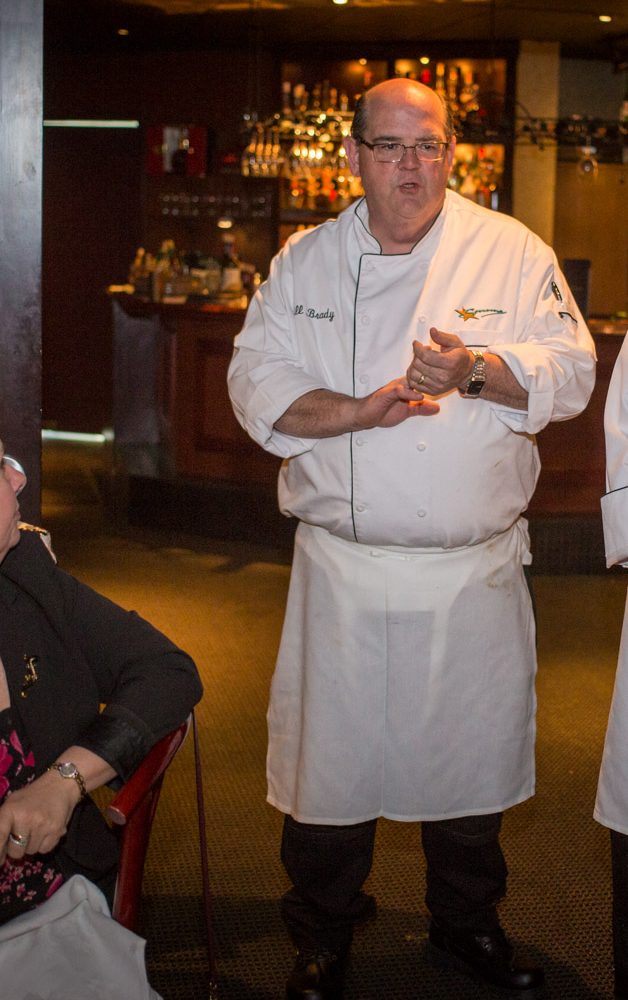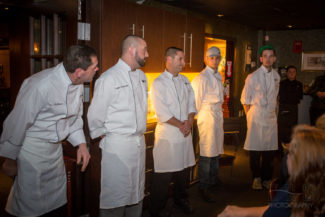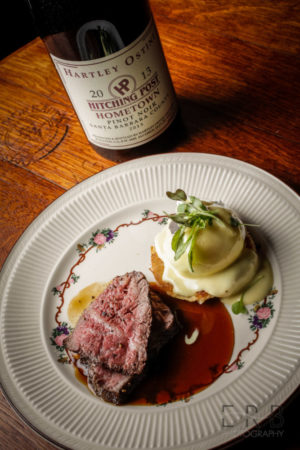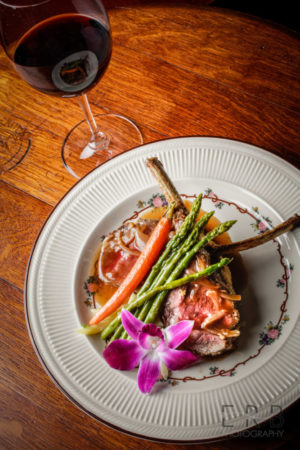
Bill Brady, chef and owner of the acclaimed Sonoma Restaurant in Princeton, stands proudly at the front of his buzzing, gleaming, enormous kitchen that extends as far as the eye can see.

Bill smiles at the energy and shouts final directions to his staff (at least those he can see) as they successfully break down from another crazy day of service. But that craziness hasn’t involved serving up plates of Sonoma’s timeless Roasted Rack of Lamb Persillade, a dish that has been on the menu since the restaurant opened in 1996. Nor would most of these kids know how to identify the Shishito Peppers that accompany Sonoma’s more contemporary Togarashi Tuna appetizer.
And that’s just fine with Bill. Because these are kids. We aren’t in his kitchen at Sonoma, which is the size of a closet compared to this behemoth. This is the kitchen at Worcester Technical High School (“The Voke”), staffed by dozens of the school’s culinary students. Service was for The Voke’s student-run Skyline Bistro, which opens to the public Tuesday through Friday.
Bill has been teaching at The Voke since shortly after the new campus opened in 2006, a move which brought his professional life full circle: He taught at the restaurant at Monty Tech (Montachusett Regional Vocational Technical School in Fitchburg) before the opportunity to open Sonoma presented itself. “I didn’t want to be one of those guys looking back saying, ‘I could’ve… I should’ve.’ I’d rather be one of those guys that said, ‘What the hell did I do that for?’” Bill says. “So, I left teaching and opened Sonoma with my wife Kim. But then this opportunity at The Voke presented itself and I thought, ‘I would like to do that again,’ because it is very gratifying.”
It also makes Bill the exception to the proverbial rule: he can do and teach. Though what he teaches at The Voke isn’t the brilliant upscale yet unstuffy fare that has had diners more than willing to make the 30-minute drive from Worcester for a generation.

“Here it is a building block menu for the kids,” he says. “The goal is to train them and be a feeder for the employers in the area. There is no elevator to success and they need to avoid thinking that way. If we can just teach them how to work then we have done our job. Who knows when you are 14 or 15 what you’re going to do for the rest of your life? These are high school kids; they don’t realize what this is all about when they start here. But if we can get them to dress nicely in this uniform and get them here ready to work and have the satisfaction of that work then we have done our job for the future.”
According to Bill, the result is chaos a lot of the time but so is life, especially life in the restaurant business, and Bill makes sure his students know they are getting real-life experience and situations. Along with department head Kevin Leighton, chefs Mike Fournier and Kim Youkstetter, and baker Dorothy Jean Rice, Bill teaches students to work as a team, the science behind the food, and the importance of health and safety as well as flavor. He knows many of these students can’t and may never make something like Sonoma’s tasty play on Steak and Eggs (coffee-rubbed Wagu beef with local porter molasses, griddled crumpet, and a poached egg with hollandaise). He also knows they may not want to. Not because they don’t have experience but because their experience with food is so different from his.
And Bill knows that’s a good thing – for him, them, and the future.
The Voke students are a diverse population many of whom never grew up eating let alone making a New England staple like the brown bread that the Leominster-born Brady did. So he teaches them, and in turn he learns about new flavors and dishes that inspire him to play with his food at Sonoma – something he and his staff love to do. They love “unusual presentations for common food” like that Steak and Eggs or the torchon of foie gras served as push up pops. (When I had these at a Chef’s Best event for Mass Foodies, they pleased the kid in me and my actual kid eating next to me.)

This approach makes Sonoma a lot like the man who runs it: a mix of unusual flavors and perennial favorites. He knows, even with all the awards and acclaim, that you’re only as good as your last meal. “You have to constantly reinvent yourself,” Bill says. “We have to deliver what is expected, stay on trend, and play. I tell my chefs, ‘We can’t be on top of the wave. We have to be in front of it too. I want to see pictures of what we did months ago in magazines. Chasing that even though it is probably never attainable is what is most fun. Still we are always taking dishes off the menu because they feel off trend or tired and customers do not respond to them. But they can come back. It is like fashion.”
His customers and culinary students can be grateful Bill came back too. In 1986, he followed the Tall Ships from Newport to New York City for the relighting of the Statue of Liberty and stayed to work for a French chef on dinner yachts (a big reason he is perfectly comfortable in the tiny confines of Sonoma’s kitchen). That classic French training gave him the technique to adapt without compromise: “I feel we owe it to the customer to give them the finest and freshest. And all of us have to understand that. I would match any of my servers against most restaurants’ cooks. They need to answer to the customers. They know cooking techniques. That is the thing you can’t get out of a chain. You can’t get that passion.”
This is why you won’t see anything at Sonoma that Bill isn’t passionate about playing with. Molecular gastronomy? Nope. Foams? No way. He might play with sous vide down the road but going into Asian markets on Green Street or Indian markets in the area, grabbing something unfamiliar, and having some fun with what he finds makes him happiest.
“We do a lot of family or staff meals with different ingredients so we can bounce ideas off of each other,” Bill says, which is how dishes like the Korean Short Ribs have found a permanent home on the menu. As for what’s great to cook with? “I’ve always turned towards the ground and the farmers. They are going to tell me what’s what.”
Looking to the future, Bill sees more of the past: “I don’t know if I buy into the idea of new versus old and cooking. Everyone is talking about preserving meats but it’s not like we didn’t do that hundreds of years ago. We let the multinational companies make our hot dogs and bologna but now we want them back, even for artisan mortadella – the ‘deli of death.’”
Bill also feels responsibility to use the trust his customers have put in him to do more with what is available. He has featured hake – a sustainable fish – that is underutilized and only uses crowd pleasers like swordfish when “the time is right and the harvest is there.” Otherwise he is a prisoner to his menu: “I don’t want to have to serve tomatoes in January or kill off a species because it is on my menu. So I’ll play around with hake or a skate wing and see if my customers respond. This is where I think the trust part comes in. A lot of people come in who have never ordered something anywhere but at Sonoma, because we have built relationships and trust.”
That sense of trust and responsibility is what also drives his need to teach: “This industry chooses you, you do not choose it. If you are willing to give up nights, weekends, family time… it is all-encompassing. It takes over your life. But the satisfaction and gratification draws you back. You know immediately if what you have done has paid off either through oohs and ahs. You also know immediately when you’ve done something wrong.”
And when he looks around the kitchen at Sonoma and The Voke, guiding and letting himself be guided he looks forward to what’s next: “I claimed ‘global cuisine’ as my category when I opened in 1996 because it represented what we were doing. But to be honest it was one of the headings allowed in the Yellow Pages. Today, for these kids, everything is global. I don’t see that ever changing.”
